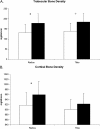Application of high-resolution skeletal imaging to measurements of volumetric BMD and skeletal microarchitecture in Chinese-American and white women: explanation of a paradox
- PMID: 20001598
- PMCID: PMC2791512
- DOI: 10.1359/jbmr.090528
Application of high-resolution skeletal imaging to measurements of volumetric BMD and skeletal microarchitecture in Chinese-American and white women: explanation of a paradox
Abstract
Asian women have lower rates of hip and forearm fractures despite lower areal BMD (aBMD) by DXA compared with white women and other racial groups. We hypothesized that the lower fracture rates may be explained by more favorable measurements of volumetric BMD (vBMD) and microarchitectural properties, despite lower areal BMD. To address this hypothesis, we used high-resolution pQCT (HRpQCT), a new method that can provide this information noninvasively. We studied 63 premenopausal Chinese-American (n = 31) and white (n = 32) women with DXA and HRpQCT. aBMD by DXA did not differ between groups for the lumbar spine (1.017 +/- 0.108 versus 1.028 +/- 0.152 g/cm(2); p = 0.7), total hip (0.910 +/- 0.093 versus 0.932 +/- 0.134 g/cm(2); p = 0.5), femoral neck (0.788 +/- 0.083 versus 0.809 +/- 0.129 g/cm(2); p = 0.4), or one-third radius (0.691 +/- 0.052 versus 0.708 +/- 0.047 g/cm(2); p = 0.2). HRpQCT at the radius indicated greater trabecular (168 +/- 41 versus 137 +/- 33 mg HA/cm(3); p = <0.01) and cortical (963 +/- 46 versus 915 +/- 42 mg HA/cm(3); p < 0.0001) density; trabecular bone to tissue volume (0.140 +/- 0.034 versus 0.114 +/- 0.028; p = <0.01); trabecular (0.075 +/- 0.013 versus 0.062 +/- 0.009 mm; p < 0.0001) and cortical thickness (0.98 +/- 0.16 versus 0.80 +/- 0.14 mm; p < 0.0001); and lower total bone area (197 +/- 34 versus 232 +/- 33 mm(2); p = <0.001) in the Chinese versus white women and no difference in trabecular number, spacing, or inhomogeneity before adjustment for covariates. Similar results were observed at the weight-bearing tibia. At the radius, adjustment for covariates did not change the direction or significance of differences except for bone, which became similar between the groups. However, at the tibia, adjustment for covariates attenuated differences in cortical BMD and bone area and accentuated differences in trabecular microarchitecture such that Chinese women additionally had higher trabecular number and lower trabecular spacing, as well as inhomogeneity after adjustment. Using the high-resolution technology, the results provide a mechanistic explanation for why Chinese women have fewer hip and forearm fractures than white women.
Figures


Comment in
-
Evolving role of imaging in the evaluation of bone structure.J Bone Miner Res. 2009 Dec;24(12):1943-5. doi: 10.1359/jbmr.091026. J Bone Miner Res. 2009. PMID: 19839775 No abstract available.
Similar articles
-
Differences in skeletal microarchitecture and strength in African-American and white women.J Bone Miner Res. 2013 Oct;28(10):2177-85. doi: 10.1002/jbmr.1953. J Bone Miner Res. 2013. PMID: 23572415 Free PMC article.
-
Trabecular bone score is associated with volumetric bone density and microarchitecture as assessed by central QCT and HRpQCT in Chinese American and white women.J Clin Densitom. 2013 Oct-Dec;16(4):554-61. doi: 10.1016/j.jocd.2013.07.001. Epub 2013 Sep 27. J Clin Densitom. 2013. PMID: 24080513 Free PMC article.
-
Differences in bone microarchitecture between postmenopausal Chinese-American and white women.J Bone Miner Res. 2011 Jul;26(7):1392-8. doi: 10.1002/jbmr.352. J Bone Miner Res. 2011. PMID: 21305606 Free PMC article.
-
Volumetric bone mineral density at the spine and hip in Chinese American and White women.Osteoporos Int. 2012 Oct;23(10):2499-506. doi: 10.1007/s00198-011-1855-z. Epub 2011 Dec 7. Osteoporos Int. 2012. PMID: 22147209 Free PMC article.
-
Mortality and morbidity in patients with osteogenesis imperfecta in Denmark.Dan Med J. 2018 Apr;65(4):B5454. Dan Med J. 2018. PMID: 29619932 Review.
Cited by
-
Differences in skeletal microarchitecture and strength in African-American and white women.J Bone Miner Res. 2013 Oct;28(10):2177-85. doi: 10.1002/jbmr.1953. J Bone Miner Res. 2013. PMID: 23572415 Free PMC article.
-
SURPRISINGLY FEW WOMEN WITH SEVERE OSTEOPOROSIS BY BONE DENSITOMETRY UNDERGO WORKUP FOR SECONDARY CAUSES - A RETROSPECTIVE EVALUATION.Acta Endocrinol (Buchar). 2021 Oct-Dec;17(4):537-542. doi: 10.4183/aeb.2021.537. Acta Endocrinol (Buchar). 2021. PMID: 35747871 Free PMC article.
-
Circulating sclerostin levels and markers of bone turnover in Chinese-American and white women.J Clin Endocrinol Metab. 2013 Dec;98(12):4736-43. doi: 10.1210/jc.2013-2106. Epub 2013 Sep 13. J Clin Endocrinol Metab. 2013. PMID: 24037879 Free PMC article.
-
High-resolution computed tomography for clinical imaging of bone microarchitecture.Clin Orthop Relat Res. 2011 Aug;469(8):2179-93. doi: 10.1007/s11999-010-1766-x. Clin Orthop Relat Res. 2011. PMID: 21344275 Free PMC article. Review.
-
Defining ethnic and racial differences in osteoporosis and fragility fractures.Clin Orthop Relat Res. 2011 Jul;469(7):1891-9. doi: 10.1007/s11999-011-1863-5. Clin Orthop Relat Res. 2011. PMID: 21431462 Free PMC article. Review.
References
-
- Barrett-Connor E, Siris ES, Wehren LE, Miller PD, Abbott TA, Berger ML, Santora AC, Sherwood LM. Osteoporosis and fracture risk in women of different ethnic groups. J Bone Miner Res. 2005;20:185–194. - PubMed
-
- Walker MD, Babbar R, Opotowsky AR, Rohira A, Nabizadeh F, Badia MD, Chung W, Chiang J, Mediratta A, McMahon D, Liu G, Bilezikian JP. A referent bone mineral density database for Chinese American women. Osteoporos Int. 2006;17:878–887. - PubMed
-
- Woo J, Li M, Lau E. Population bone mineral density measurements for Chinese women and men in Hong Kong. Osteoporos Int. 2001;12:289–295. - PubMed
-
- Xiaoge D, Eryuan L, Xianping W, Zhiguang Z, Gan H, Zaijing J, Xiaoli P, Hongzhuan T, Hanwen W. Bone mineral density differences at the femoral neck and Ward's triangle: A comparison study on the reference data between Chinese and Caucasian women. Calcif Tissue Int. 2000;67:195–198. - PubMed
-
- Russell-Aulet M, Wang J, Thornton JC, Colt EW, Pierson RN., Jr Bone mineral density and mass in a cross-sectional study of white and Asian women. J Bone Miner Res. 1993;8:575–582. - PubMed
Publication types
MeSH terms
Grants and funding
LinkOut - more resources
Full Text Sources
Medical

